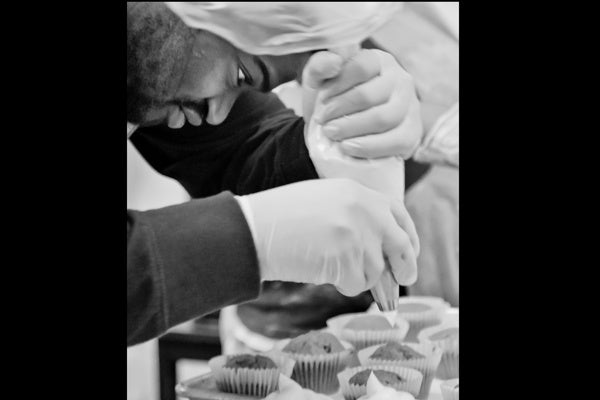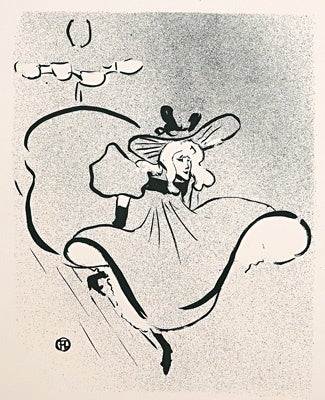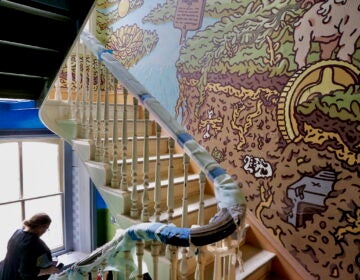Toulouse-Lautrec exhibit vividly captures denizens, desires of Belle Époque
The 150 prints and drawings featured in the Allentown Art Museum’s summer exhibition, “Toulouse Lautrec and His World,” show that the little man from Paris was a master of the accouterment.
Henri de Toulouse-Lautrec drew thick Frenchman filling out their enormous black overcoats. Waspy-waisted showgirls were made top-heavy with plumed hats. There is so much to a ruffled collar, or a fur muff.
“He knew how to capture the essence of actors and individuals,” said curator Diane Fischer. “[Singer] Yvette Guilbert always wore black gloves. He turned the gloves into icons. He worked with graphic symbols that capture the essence of different things.”
While his contemporaries were changing art with impressionistic flowers and gardens, Toulouse-Lautrec didn’t give a whit for landscapes. People, and what they wore, were all he cared about. He immortalized the singer and nightclub owner Aristide Bruant with a walking stick and flaming red scarf.
The academic-trained painter produced more than 5,000 drawings and nearly 400 prints in his short life, all of them featuring faces and figures. The include iconic advertisements for the Moulin Rouge and the performer Jane Avril performing the can-can.
He also produced oil paintings, none of which are on display in Allentown. The traveling show, produced by the Herakleidon Art Museum in Athens, Greece, is assembled from the collection of one man, Paul Firos, who used his computer software fortune to get as many works on paper by Toulouse-Lautrec (and M.C. Escher) as possible.
Allentown is the second of three American stops for the exhibition.
A sense of the cabaret
Fischer piped cabaret music into the gallery to evoke the environment where Toulouse-Lautrec thrived. He loved the cabaret, the people who drank in them, and mostly the performers on stage.
He illustrated a book about the bawdy singer Guilbert, with an abstraction of her long black gloves on the cover. Inside are pages and pages of Guilbert’s haughty frown.
“She said to him, ‘I’m not that ugly.’ She didn’t like it at first,” said Fischer. “Then it became popular, and she became very well known as a result of the book. Then she began to like it.”
Everybody seemed to like Toulouse-Lautrec. An aristocrat by birth, he preferred working-class neighborhoods where he could pal around with artists, anarchists, and prostitutes. His oil paintings were featured in salons, but he also did illustrations for magazines, books, fliers, posters and even party invitations.
Toulouse-Lautrec’s aristocratic pedigree gave him a genetic bone condition, making him abnormally short and unable to walk without a cane. It also made him the recipient of old money, and lots of it. Toulouse-Lautrec did not have to work for a living. Nevertheless, he churned out hundreds of cartoons and sketches for publications including Le Rire, a humor magazine, and L’Esarmouche, a short-lived anarchist magazine.
He also illustrated a book in defense of the Jewish military officer Alfred Dreyfus, who was falsely accused of espionage by an anti-Semitic French court, a major scandal of the day. Toulouse-Lautrec’s dark, heavily cross-hatched drawings are on display in the exhibition.
Exploring the world of prostitutes
The Allentown museum made a small, domestic tableau out of three colored sketches of women in brothels. The blood-red niche outfitted with French antiques included a drawing of a young nude in profile, sans accouterments.
“Because he did not have to work he was free to be innovative,” said Fischer. “The pictures of prostitutes — Edgar Degas earlier did pictures of prostitutes, but he kept them to himself. Lautrec did a book about prostitutes that came out immediately.”
Toulouse-Lautrec’s joie-de-vivre illustrations depicted the life that would ultimately kill him. At age 36 he died of alcoholism and syphilis.
The exhibit continues at the Allentown Art Museum, 1 N. Fifth Street, Allentown, Pa., through Sept 1.
WHYY is your source for fact-based, in-depth journalism and information. As a nonprofit organization, we rely on financial support from readers like you. Please give today.




























